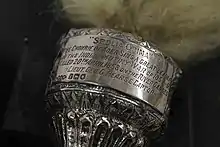George Godfrey Pearse
George Godfrey Pearse (born 4/1/1827, Berhampore, Madras; died 5/12/1905 London, UK), was a renowned British archeologist of South India, Lt-Gen., Col. Commandant Royal Horse Artillery and Companion of the Bath. He commanded the 3rd Regiment of the Sikh Irregular Cavalry.[1]
Military career
An officer in the Royal Artillery, George Godfrey Pearse served in the Madras Artillery from 1845 and later became Colonel Commandant of the Royal Horse Artillery. His extensive military diary, currently kept at the Royal Military Museum covers his service during the period of 1848-1849 including the siege of Multan, 1848-1849 in the 1st Sikh War, and his participation on the Afghan frontier and the Punjab War, 1848–9; northwest Frontier, 1849–55; Indian ‘Mutiny’, 1857–9.

Legacy
His extensive archeological field research recording South India ancient sites from his excavations, Lt-Col. George Godfrey Pearse presented a collection of South Indian Iron Age tools to the British Museum in 1868. This collection is the first excavated of its kind, in 1867, his findings were published in an article in the Journal of the Ethnological Society of London.[2] His personal diaries, papers, letters, are kept in the British Library, the Royal Artillery Museum and Trinity College, Cambridge.[3] His diaries[4] kept at the British Library date from the time when he was Lt. Pearse, providing meticulous details of his excavations and findings including coins[5] of the Andhra dynasty collected during his military-station in Andhra Pradesh located in the Indian subcontinent, as noted in the British Museum Catalogue of Indian Coins, that was presented by the Government of India[6] On the Excavation, it was also discovered a large raised Stone Circle or Barrow near the Village of Wurreegaon, one mile from the Military Station at Kamptee, Central Provinces of India.[7]
Family Background & Marriage
George Godfrey was the son of Medical Dr. George Pearse,[8] of Edinburgh, later Godfrey House of Cheltenham; Hon. Physician to Queen Victoria; and his wife Anne Sarah McCulloch, daughter of James McCulloch, Esq., of Strabane. In 1824 his family sailed to Madras for the East India Co. on the ‘Duke of Bedford’ a ship of the line of the Royal Navy.
On the 6/5/1879 at Great Kimble, Bucks, George Godfrey married Lady “Zoë” Louisa Hester Stuart, the youngest daughter of Rev. John Steward, vicar of Great Kimble. Their marriage issued:
- Zoë Dorothy Pearse (b. 24/3/1880, Bangalore btd 6/5/1880, St Mark’s, Bangalore; d. 2/2/1894, London; brd Great Kimble)
- Godfrey Pearse, Lt, 13th Madras Infantry;( b. 28/10/1881, Ootacamund; educated at Royal Military College, Sandhurst; d. 2/4/1920, UK)
Note: He was the God-father of his brother Charles's son Lt. Godfrey Robarts Pearse, a fencer and later renowned British writer.
Bibliography
- Monumental Inscription, Great Kimble 30. George Godfrey Pearse C.B. Colonel Commandant Royal Horse Artillery born 4th Jan 1827 died 5th Dec 1905
- Bucks Herald, reported obituary: The Late General Godfrey Pearse, 23 Dec 1905. General George Godfrey Pearse, C.B., Colonel Commandant R.H.A., who died at Soraba, Shanklin, Isle of Wight, on the 5th December, aged 79 years, was on Saturday, Dec. 9, laid to rest in the quiet and beautiful Churchyard of Little Kimble, of which Church Mrs. Pearse's father-in-law was the late vicar.
- UK Buckinghamshire Parish Registers: Bucks Herald, Marriages: reported, Fashionable Marriage, 17 May 1879. On Tuesday, May 6, this quiet village was the scene of a brilliant and interesting ceremony - the marriage of Louisa Hester Steward, youngest daughter of the late Rev. J. Steward, for some years the Vicar of the parish, with Sir George Godfrey Pearse, Colonel in the Royal Horse Artillery of the UK.
References
- Pearse Family Genealogy - British Archive, UK |http://blogs.cardiff.ac.uk/brodbecksp/wp-content/uploads/sites/129/2010/08/Pearsetree9.pdf
- 1867 Records: Iron Age material from South India; George G. Pearse findings article published in the Journal of the Ethnological Society of London, volume 1
- Pearse Records, UK National Archives|website: www.nra.nationalarchives.gov.uk/nra/searches/pidocs.asp
- Philippart, John: The East India Military Calendar; containing the Services of General and Field Officers of the Indian Army. Kingsbury, Parbery, and Allen [London[ 1823 4to Volume 1 |https://www.bateshindmarch.com/product/east-india-military-calendar-1823-copy-of-volume-1-only-but-with-a-very-distinguished-original-ownership/
- H.A. Grueber #39s, Preface to BMC Indian Coins of the Andhra dynasty, 1908. British Museum Archives, London UK
- G.G. Pearse archaeological findings, by J.H. Marshall, Director-General of Archaeology in India to the British Museum in 1908.
- Discoveries of Lt-Col. George G. Pearse, Journal of the Ethnological Society of London, vol. 1, 1869 (pp. 207-17)
- Pearse Family Genealogy (p.2) - British Archive, UK |http://blogs.cardiff.ac.uk/brodbecksp/wp-content/uploads/sites/129/2010/08/Pearsetree9.pdf